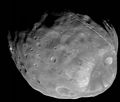فاىل:Phobos colour 2008.jpg

اي پيشأدئنˇ واويراز: ۶۳۶ × ۶۰۰ پيکسل. کیفیتهای دیگر: ۲۵۵ × ۲۴۰ پيکسل | ۵۰۹ × ۴۸۰ پيکسل | ۸۱۵ × ۷۶۸ پيکسل | ۱٬۰۸۶ × ۱٬۰۲۴ پيکسل | ۲٬۱۷۲ × ۲٬۰۴۸ پيکسل | ۳٬۵۰۰ × ۳٬۳۰۰ پيکسل.
أصلˇ فاىل (۳٬۵۰۰ × ۳٬۳۰۰ پیکسل، فاىلˇ واويراز: ۲٫۷۲ مگابایت، نوع MIME فاىل: image/jpeg)
فاىلˇ تاريخ
تاريخ/زمتؤنˇ سر کيليک بکۊنين تا اۊ تاريخ/زمتˇ نۊسخه' بىنين.
| تاريخ/زمت | کلˇ أنگۊشتي | أبعاد | کارگير | نظر | |
|---|---|---|---|---|---|
| ألؤنˇ نۊسخه | ۲ آوريل ۲۰۱۸، ساعت ۰۳:۱۰ |  | ۳٬۵۰۰ در ۳٬۳۰۰ (۲٫۷۲ مگابایت) | Kaldari | more margin on right side |
| ۱۳ نؤوامبر ۲۰۰۸، ساعت ۰۴:۴۷ |  | ۳٬۳۷۴ در ۳٬۳۰۰ (۲٫۷ مگابایت) | Fir0002 | == Summary == {{Information |Description=Colour image of Phobos, imaged by the Mars Reconnaisance Orbiter in 2008 |Source=NASA |Date=9 April 2008 |Location=http://www.nasa.gov/mission_pages/MRO/multimedia/pia10368.html |Author=NASA/J |
فاىله کارأىتن
اي ولگؤن اي تاتاىئه خال بدأ دأنن:
فاىلˇ سراسري کارأىتن
اي ويکئن اي فاىله کارأىته دأنن:
- af.wikipedia.org مئن کارأىتن
- an.wikipedia.org مئن کارأىتن
- ar.wikipedia.org مئن کارأىتن
- المريخ
- فوبوس
- قمرا المريخ
- ويكيبيديا:صور مختارة/الفضاء والكون/نظرة إلى الأعلى
- قائمة أجرام المجموعة الشمسية مرتبة حسب الحجم
- بوابة:علم الفلك/صورة مختارة
- بوابة:المريخ
- بوابة:المريخ/مقالة مختارة/أرشيف
- بوابة:المريخ/مقالة مختارة/2
- قائمة الأقمار الطبيعية
- خط زمني لاكتشاف كواكب المجموعة الشمسية وأقمارها
- ويكيبيديا:ترشيحات الصور المختارة/القمر فوبوس
- ويكيبيديا:صورة اليوم المختارة/أغسطس 2019
- قالب:صورة اليوم المختارة/2019-08-03
- بوابة:علم الفلك/صورة مختارة/73
- معسكر قاعدة المريخ
- ويكيبيديا:صورة اليوم المختارة/يناير 2022
- قالب:صورة اليوم المختارة/2022-01-04
- ary.wikipedia.org مئن کارأىتن
- arz.wikipedia.org مئن کارأىتن
- as.wikipedia.org مئن کارأىتن
- azb.wikipedia.org مئن کارأىتن
- az.wikipedia.org مئن کارأىتن
- be-tarask.wikipedia.org مئن کارأىتن
- be.wikipedia.org مئن کارأىتن
- bg.wikipedia.org مئن کارأىتن
- bh.wikipedia.org مئن کارأىتن
- bn.wikipedia.org مئن کارأىتن
- bn.wikibooks.org مئن کارأىتن
- bs.wikipedia.org مئن کارأىتن
نمایش استفادههای سراسری از این پرونده.





